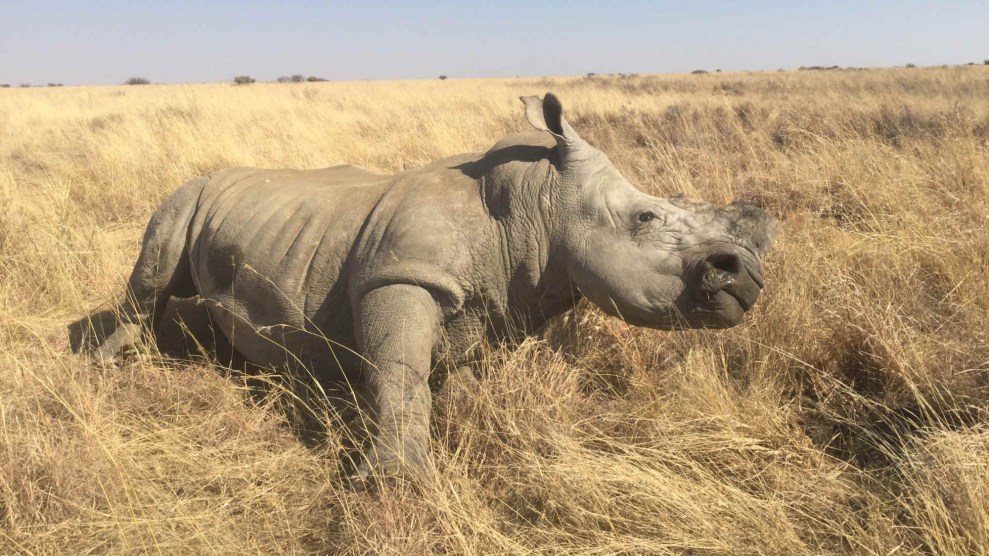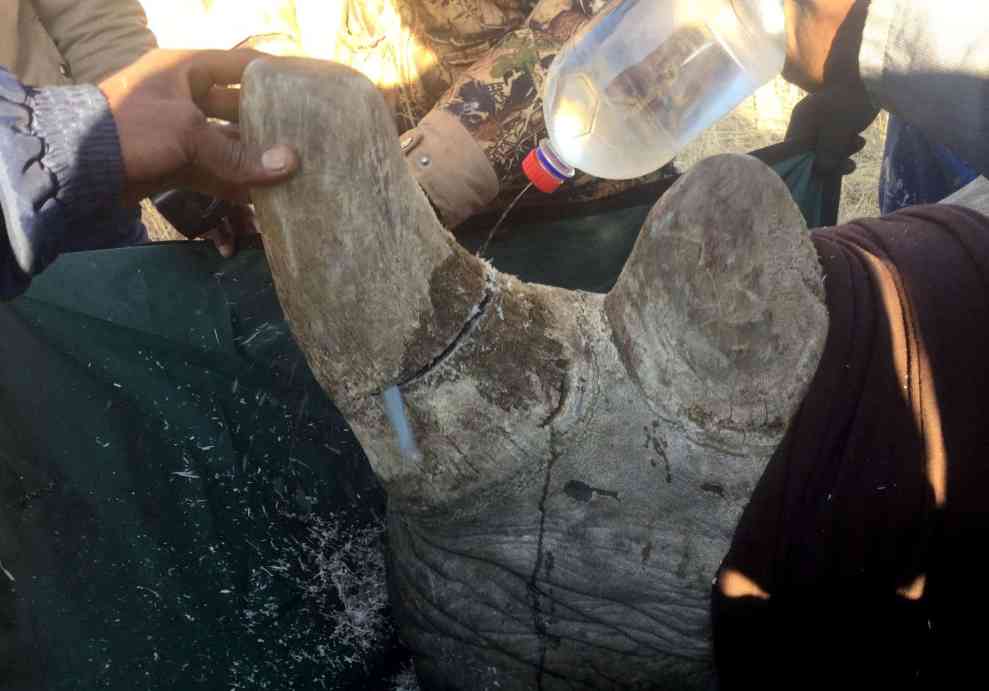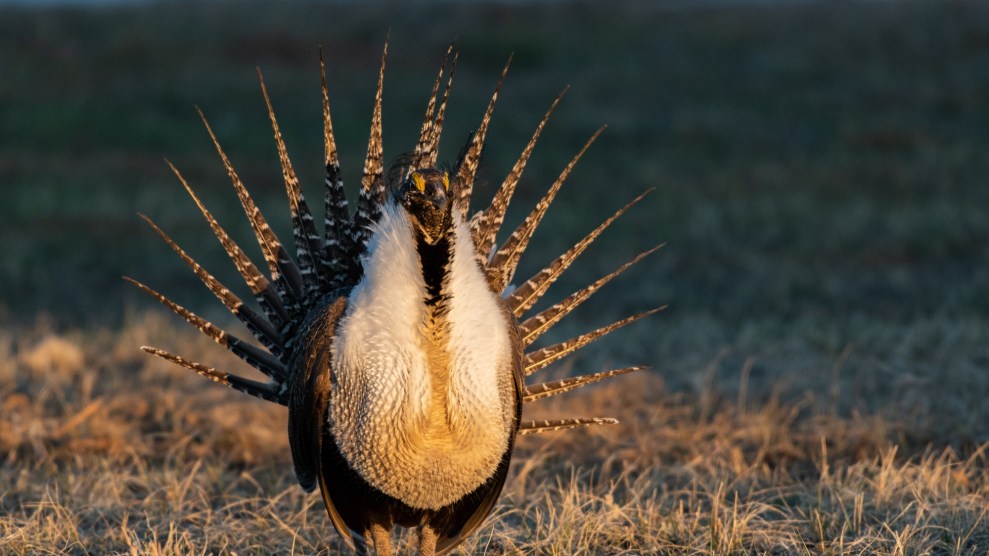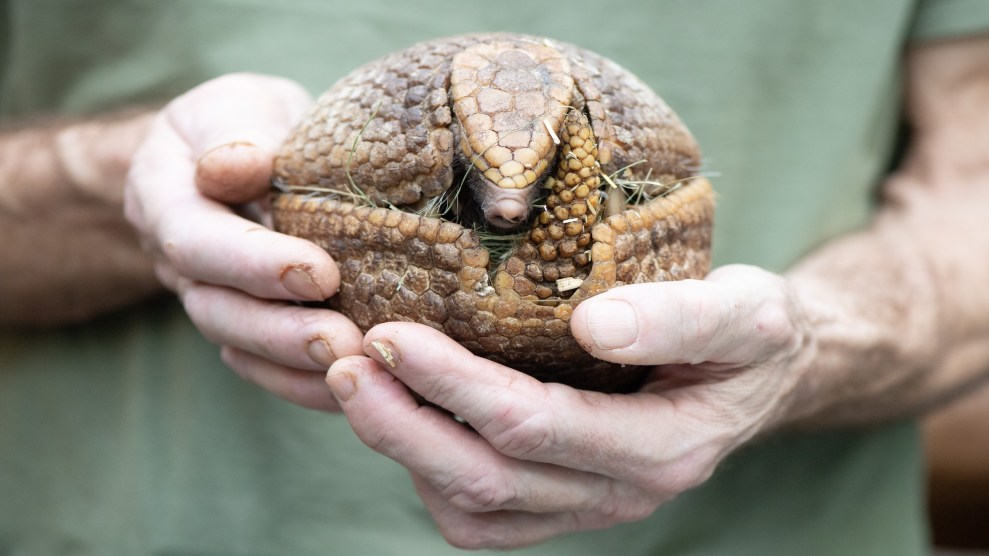
A freshly dehorned white rhino bull emerges from the grog of a tranquillizer at John Hume’s ranch in South Africa on August 5, 2021.Ed Stoddard/Undark
This story was originally published by Undark and is reproduced here as part of the Climate Desk collaboration.
Three hours outside Johannesburg, the gravel road to John Hume’s home slices through grasslands tinged a parched amber hue as the winter dry season fades. The former hotel mogul owns the world’s largest privately held rhino population: 2,000 southern white rhinoceroses, roaming 21,000 acres of former crop and cattle lands. A 60-mile long electrified fence rings the property. Its two-fold role is to keep the pachyderms in and poachers out.
Hume has not lost a rhino to poachers in almost five years, thanks to formidable security. Over the past decade though, state-run parks have been overwhelmed by poachers, who can sell a single rhino horn for six-figure sums. As those wild populations decline, research suggests nearly half of South Africa’s estimated 12,300 white rhinos are now in private hands. With the trend of private breeding growing rapidly, some experts say this number may even have already surpassed 50 percent.
But the fate of Hume’s rhinos—and South Africa’s unusual game privatization experiment—hang in the balance. In December 2020, a government panel recommended phasing out intensive and captive rhino breeding in the country, as part of a broader set of policies for wildlife conservation. According to the panel and a subsequent government policy paper, captive breeding operations like the one owned by Hume are potentially harming the species’ future.
In an email to Undark, the panel’s chair, Pamela Yako, expressed two concerns about intensive breeding and management: “that this, firstly, compromises the genetics of the population and secondly compromises their ability to independently survive in the wild.”
While Yako and her colleagues acknowledge the role of private reserves in helping to build up rhino populations, they conclude it’s time to move the more intensively managed private populations back into wilder habitats.
The panel’s report has been accepted by the South African cabinet, signaling top-level political support. After a public comment period, the Department of Forestry, Fisheries, and the Environment will refine the policy, then draft a white paper to send to Parliament.
But the prospect of losing their herds has alarmed many private rhino owners and conservationists, who say the policy will make southern white rhinos more vulnerable to poaching. “We have rhino in well-protected zones,” said Pelham Jones, chairman of the Private Rhino Owners Association, or PROA. Now, he added, “the government is recommending that these captive breeding operations, which have proven to be highly, highly successful, and are achieving the best breeding outcome one could hope for, are to be shut down.” The group is considering all options, including a legal challenge that would potentially ensnare the process in years of legal wrangling.
At stake here are questions about how best to preserve a threatened species. The politics are fraught as well, and charged by South Africa’s racial tensions: Proponents of the new policy point out that the country’s Black majority has often been excluded from the benefits of rebounding game populations. By PROA’s own estimates, there are between 150 and 180 private rhino owners in South Africa; nearly all of them are White.
None of them has an operation as large as Hume’s, whose herd may account for up to 13 percent of the global population of white rhinos. His ranch also appears to be a prime target of the new legislation. In her email, Yako expressed concerns about “a single operation that has a large number of rhino under intensive management and breeding”—seemingly a reference to Hume, although Eleanor Momberg, a spokesperson for the Department of Forestry, Fisheries and the Environment, wrote in an email to Undark that Yako and other panelists were no longer available for further comment because their contracts had expired.
The new policy could eventually undermine the legal basis for Hume’s breeding project, leaving the herd in limbo. It’s unclear who would take over Hume’s herd—and how a South African state balancing intense fiscal pressures with massive social needs would pay for a mass rhino relocation.
Sitting in his modest home office, which is adorned with rhino pictures and carvings, Hume maintained he is adding to an endangered species’ numbers. “Surely that’s what we all want,” he told Undark. “Show me the good grazing, and assure me that you can keep the bullets away, and I will show you my rhinos thriving.”

A tranquilized bull rhino gets a trimming at John Hume’s ranch in South Africa on August 5, 2021.
Ed Stoddard/Undark
Africa is home to two of the five surviving rhinoceros species: the larger white rhino, a grass grazer, and the smaller black rhino, which browses on trees and bushes. In the late 19th century, European settlers killed thousands of the animals. Every southern white rhino today is descended from a single population in South Africa’s KwaZulu-Natal province. In the 1890s, the animals reached their low point, numbering just a few dozen.
From this bastion—now called the Hluhluwe-Imfolozi Park—the population rebounded. By the 1960s, flush with rhinos, a government organization called the Natal Parks Board began selling and donating animals to other African reserves, and to zoos around the world. In 1986, Natal Parks Board started selling to private operations, too. Five years later, the South African government passed the Game Theft Act, which allows people to own rhinos and other game on their property, provided it has been enclosed with fencing.
The law has critics. In a 2015 dissertation, scholar Dhoya Snijders described the act as “one of the largest and most unnoticed transfers of common goods to private landowners in the country’s history.”
Thanks to the new legislation, game ranchers began to rapidly accumulate rhinos to breed and trade for profit, to draw ecotourists, and to stage expensive hunts. Nowadays, most owners also slice off the animals’ horns and store them, in the event that a now 44-year-old global moratorium on the rhino horn trade is lifted. These owners argue that trading rhino horn may help regulate its illicit traffic and would provide substantial revenue to cover the large costs associated with managing and conservation of the species, said Jones. Comprised of keratin—the substance in human fingernails—rhino horn can grow back after it is trimmed, an operation that entails tranquilizing the animal. De-horning is also aimed at thwarting poachers by removing their ultimate target.
By 2010, there were 18,800 white rhinos in South Africa, according to estimates from the International Union for Conservation of Nature, of which at least 5,500 were privately owned.
But as demand for rhino horn grew in newly-affluent Asian economies such as Vietnam—where consumers prize its alleged medicinal properties—poaching surged. A record 1,215 rhinos were poached in South Africa in 2014.
Although numbers have dropped since then, poachers still take hundreds of animals per year. The activity has centered on Kruger National Park, South Africa’s flagship wildlife reserve. The park is vast—roughly the size of New Jersey—making it difficult for the cash-strapped government to police. And entrenched poverty in neighboring communities has pushed some people toward poaching.
Today, as state losses mount, poachers are increasingly targeting private reserves. Government data shows 15 percent of rhinos poached in 2019 were on private land. In the first six months of 2021, that spiked to 30 percent. Owners who can afford it invest heavily in security. Meanwhile, many small-scale rhino ranchers have sold out because of costs.
At least so far, the scale of Hume’s operation—and his deep pockets—have fended off poachers. At Hume’s “Ops Center,” 10 TV screens line one wall. Radars and thermal cameras monitor the property, covering the rhinos’ range and the public roads that cut past the ranch. The flat, grassy terrain is ideal for the motion-detecting radars, which cannot penetrate solid objects such trees or buildings. If an intruder gets over the electrified fence, concealed speakers blare warnings while a team rushes to intercept.
“We are always ready, and we can fly a chopper to the scene quickly if we need to,” said Brandon Jones, a helicopter pilot and Hume’s head of security, with a handgun holstered to his hip. The team’s arsenal includes assault rifles; the poachers are also heavily armed. Hume, who refers to the team as his “private army,” said security costs him $2 million per year.
The investment seems to be working. While poachers killed 32 of Hume’s rhinos between 2007 and 2017, he says he has not lost an animal since. More of his rhinos have been killed by lighting strikes.
According to Hume, the operation has accumulated nearly 9 tons of rhino horn, worth a nine-figure sum on the black market. But, he said, his passion for rhinos was driven by the species’ plight in the cross-hairs of poachers, not potential profits. “I always liked breeding,” he said. “I became aware in the early ‘90s of the slaughter of rhino elsewhere in Africa. They were being slaughtered to extinction.” Around that time, he purchased his first 10 animals.
Today, driving around the property, it’s possible to see clumps of rhinos amid the windswept landscape of long wild grass, punctuated by the occasional tree. Other times, there are no signs of the big critters at all, beyond their telltale scat in the soil.

Brandon Jones, head of security at John Hume’s rhino fortress.
Ed Stoddard/Undark
Inside this gated fortress, the number of rhinos on Hume’s ranch has swelled: Between 2008, when he started breeding at his current ranch, and September 2021, Hume’s rhinos had given birth to some 1,690 calves. But whether that growth is an unmitigated good for rhino conservation, or a liability for the future of the species, remains contested.
Yako and other critics of captive breeding have raised concerns that the closely managed life on the ranch could give rise to domestication, a fate that historically has not occurred in any large African mammal, or render the rhino unsuitable for rewilding.
Hume’s rhinos are divided into breeding areas surrounded by electric fencing averaging 1,200 acres. The animals roam, graze, and mate freely in their allotted spaces. But they are intensely monitored, and each enclosure or camp has a ranger who does a daily headcount, often on horseback. Still, Michelle Otto, Hume’s resident and full-time veterinarian, said the animals are far from domesticated. “We are only on our second generation now,” she said, as she prepared medicine for an old cow rhino with hip problems. “I’ve been chased into a tree by a white rhino here because I went in on foot, and one didn’t take a liking to me, and she stormed me.”
Otto said the animals can be habituated to certain vehicles—but, she noted, even wild Kruger rhinos are now accustomed to cars. The ranch does supplemental feeding, mostly in the dry winter months, which Otto said was at most 40 percent of the rhinos’ daily intake. “The rest they take off the veld,” she said.
Some of Hume’s rhinos have already been successfully reintroduced into the wild. Hume sold his last 16 black rhinos—famed for their ornery temperament—to the small kingdom of Eswatini, which borders South Africa. “This group of rhinos has been suitable for introduction, save for one young male which was hand-raised,” wrote Mick Reilly, conservation and security executive with Eswatini’s parks, in an email.
“Hume’s white rhinos as a whole would be suitable for re-introduction into the wild,” added Reilly, who has visited the ranch.
Yako and others have also expressed concerns about the genetic diversity of rhinos in captive breeding populations. Even in the wild, rhino genetics pose serious issues: A century ago, when population numbers were so low, the bottleneck reduced the genetic variability of the species. According to Petra Kretzschmar, a biologist and rhino expert at the Leibniz Institute for Zoo and Wildlife Research in Germany, this state of affairs made the species vulnerable to disease and fertility problems.
Compounding the issue, rhinos tend to mate with their relatives. “Inbreeding is unfortunately a big threat to the white rhino population,” Kretzschmar wrote in an email. “It is therefore very important to prevent rhinos from inbreeding.”
In a 2020 study of rhino breeding patterns on a large private ranch in South Africa’s northern Limpopo province, Kretzschmar and several colleagues found that white rhinos are not choosy about mating with kin. The study, published in the journal Evolutionary Applications, found “no sign of inbreeding avoidance: Females tended to mate more frequently with closely related males.” The researchers recommended rotating breeding bulls every six years—the time it takes a female to reach sexual maturity—between reserves.
Kretzschmar, who has visited Hume’s ranch, said policies there do effectively address the issue. Otto keeps detailed records in a stud book to prevent inbreeding. Compared to the private reserve where her study was conducted, Kretzschmar said in a phone interview, Otto “has the benefit that the rhinos can be monitored much better,” as they are put into a smaller spaces that can be more readily observed.
“So her records are much more accurate, which results in the fact that she knows exactly who has fathered whom and can immediately move an animal to a different camp to prevent inbreeding,” said Kretzschmar.
In the paper, Kretzschmar—who also does paid consulting for a private game ranch—and her co-authors said South Africa’s private reserves may be the last refuge for the species.
Still, Hume’s approach has critics. “In John Hume’s case, there is control over the breeding,” said Dave Balfour, an ecologist and member of the IUCN African Rhino Specialist Group who contributed to the government report arguing for reimagining rhino conservation in the region. He says these breeding strategies “are not anywhere near the gold standard.”
“A natural rhino population has 50/50 male/female” Balfour said, adding that Hume’s project had somewhere around 50 cows to three or four bulls. “That is not a natural mating selection system.” (In a WhatsApp message, Otto defended the ranch’s arrangement. “We are a breeding operation, therefore we are skewed towards having higher female densities in a set location than in the wild,” she wrote, adding that females are permitted to choose among two or three bulls.)
Other critics have concerns about the stockpiling of rhino horn, detecting a profit motive beneath a facade of conservation. “Are you trying to mask an economic incentive behind a conservation philosophy?” asked Neil Greenwood, the Southern African director for the International Fund for Animal Welfare, an NGO. “I don’t think that the captive breeding is necessarily the most effective way to protect those animals.”
At issue are larger questions about the future of wildlife in South Africa, where populations of large, charismatic animals have rebounded. Many are in private hands: Today, according to the government report, there are 9,000 private game ranches in South Africa, comprising around 50 million acres.
The growth of private game reserves has raised some concerns about equity. South Africa is the most unequal society in the world, according to the World Bank, and land ownership patterns remain skewed in favor of the White minority.
According to the government policy paper, many communities with historical ties to wildlife lands have been walled out of the present conservation arrangement. “The forceful removal of people from the land led to the current South African ‘Wildlife Model,’ the report says, “where the largest percentage of wildlife land is owned by the White minority and by the state, with few wildlife resources on community lands.”
Critics note that these conservation disputes are unfolding amid persistent government failures to enact land reforms. “The disparities in ownership in the wildlife industry somewhat reflects what we see in other sub-sectors of agriculture, where participation of Black farmers remains marginal,” said Wandile Sihlobo, the chief economist at the Agricultural Business Chamber of South Africa and author of a recent book on land reform in the country.
As part of its vision, the government panel calls for the removal of fences separating many conservation areas. The report envisions “an authentic wild sense of place” with “larger contiguous areas containing vibrant self-sustaining populations” of elephants, buffalos, lions, leopards, rhinos, and other species.
That’s far from the present reality: In South Africa all megafauna except leopards are contained in fenced areas of some kind. And the government panel’s broader vision of wildness has elicited some skepticism from conservationists—and private rhino owners. In a written submission raising objections to the new policy, PROA argues that “human beings in South Africa and across the world simply do not have the luxury of a utopian concept of wild animals roaming across millions of hectares of unfenced, uninhabited, and human-free plains.”
In an email, Momberg wrote that Barbara Creecy, minister of Forestry, Fisheries, and the Environment, preferred not to comment, explaining that officials are still reviewing public responses to the proposal.
For now, Hume’s rhino breeding operation is continuing to grow. On a recent morning, Otto and other Hume employees prepared to dehorn 19 bulls—a brisk, clinical undertaking.
While the rhinos may live carefully managed lives on a ranch, they remain dangerous. Aiming a rifle-like tranquillizer gun out the window of her Toyota Landcruiser, Otto shot a dart into each rhino, generally from around 50 yards. As the rhino wobbled, a member of the up to 15-person crew pulled a blindfold over its eyes, while several men ran in to keep the animal upright. Once the rhino was lying on its chest, one of the ranch’s managers used a hand-held electric saw to do the trimming.
“We are cutting above the growth plate,” Otto said as the saw sliced through the horn of a 2-ton bull. “The section they are trimming is excess horn that contains no blood vessels or nerves.”
When the trimming was complete, Otto injected the rhino with an antidote to the tranquilizer.
“You don’t want to be next to him when he wakes up,” she cautioned. The situation was unnatural, but a rhino is a rhino.












